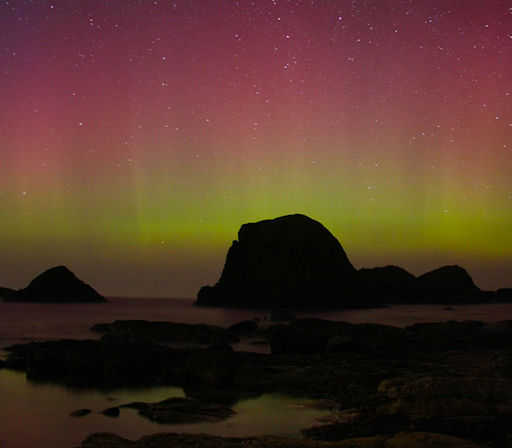IS IT SNOWING MICROBES ON ENCELADUS? As NASA's Cassini spacecraft completes its deepest-ever pass through the plumes of Enceladus, researchers are wondering if it might be snowing microbes there. The idea is not so far-fetched, they say, as evidence mounts for a "uniquely accessible" habitable zone on Saturn's icy moon. [full story]
NORTHERN LIGHTS: A geomagnetic storm is brewing around the Arctic Circle. Last night in Europe, Northern Lights descended as far south as N. Ireland, shown here in a photo taken by Martin McKenna at Ballintoy Harbour in County Antrim:
"What a stunning night," says McKenna. "Auroras were visible for more than 6 hours with two major outbursts and numerous rays. The lights looked amazing over the sea with the ancient rocks of Ballintoy Harbour below."
The cause of the display is the interplanetary magnetic field (IMF), which is tipping south and opening a crack in Earth's magnetosphere. As solar wind pours in, the sky lights up. More high-latitude auroras are possible tonight: NOAA forecasters estimate a 50% chance of polar geomagnetic storms as the solar wind continues to blow.
more images: from Chris Allington of Crofton, Nebraska; from Nenne Åman of Arjeplog Northern Sweden; from Randy Halverson of Kennebec, South Dakota; from Paul Martin of Ballintoy Harbour, Antrim coast, N.Ireland; from Claus Vogel of Pelly Crossing, Yukon; from David Done of Anzac, Alberta Canada; from Ray Mckenzie of Saskatoon, Saskatchewan, Canada; from Dirk Obudzinski of Eagle Summit, Alaska; from Adrian Maricic of Loch Leven, Fife Scotland; from Mark Shaw of Dungiven, Northern Ireland

![]()
Solar wind
speed: 418.8 km/sec
density: 0.1 protons/cm3
explanation | more data
Updated: Today at 1714 UT
![]()
X-ray Solar Flares
6-hr max: B4 1134 UT Mar28
24-hr: B7 0025 UT Mar28
explanation | more data
Updated: Today at: 1700 UT
![]()
![]()
![]()
Daily Sun: 28 Mar 12
![]()
![]()
None of these sunspots pose a threat for strong solar flares. Credit: SDO/HMI
![]()
![]()
![]()
Sunspot number: 63
What is the sunspot number?
Updated 27 Mar 2012
Spotless Days
Current Stretch: 0 days
2012 total: 0 days (0%)
2011 total: 2 days (<1%)
2010 total: 51 days (14%)
2009 total: 260 days (71%)
Since 2004: 821 days
Typical Solar Min: 486 days
Updated 27 Mar 2012
The Radio Sun
10.7 cm flux: 106 sfu
explanation | more data
Updated 27 Mar 2012
![]()
![]()
![]()
Current Auroral Oval:
![]()
Switch to: Europe, USA, New Zealand, Antarctica
Credit: NOAA/POES
![]()
![]()
![]()
Planetary K-index
Now: Kp= 2 quiet
24-hr max: Kp= 4 unsettled
explanation | more data
![]()
Interplanetary Mag. Field
Btotal: 3.7 nT
Bz: 0.4 nT north
explanation | more data
Updated: Today at 1713 UT
![]()
![]()
![]()
Coronal Holes: 26 Mar 12
![]()
![]()
A solar wind stream flowing from the indicated coronal hole could reach Earth at the end of March. Credit: SDO/AIA.





